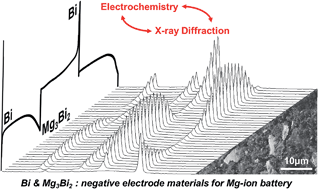Insight into the electrochemical behavior of micrometric Bi and Mg3Bi2 as high performance negative electrodes for Mg batteries†
Abstract
The electrochemical behavior of micrometric Bi powder as an active electrode material for Mg batteries is revisited in a half-cell with Mg metal as the counter electrode and organohaloaluminate-based complex electrolyte. A complete biphasic domain is evidenced from Bi to its Mg-alloyed counterpart Mg3Bi2. Operando X-ray diffraction underlines a simple mechanism that does not imply any intermediate phases or amorphization process. The high performances of Bi-based electrodes are confirmed using an optimized electrode formulation, with specific capacity nearing the theoretical value of 385 mA h g−1 at low rates. The capacity fading appears limited when moving to high current densities. In parallel, a micrometric Mg3Bi2 intermetallic compound obtained by high-energy ball-milling exhibits a similar electrochemical behavior. As a proof-of-concept as-prepared Mg3Bi2 is directly associated with a Chevrel-type positive electrode and successfully tested as a complete Mg-ion battery. Despite the high molar mass, the couple Bi/Mg3Bi2 can be considered as a reliable negative electrode candidate and a reference system for testing the next generation of Mg-ion battery electrolytes.

- This article is part of the themed collection: 2015 Journal of Materials Chemistry A Hot Papers


 Please wait while we load your content...
Please wait while we load your content...